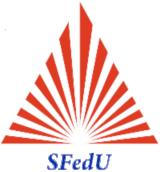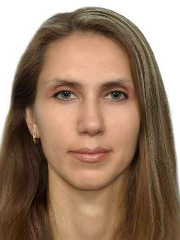Pedagogy. Theory and methods of education and training on the base of ICT. Informatization of education. Organization of independent educational activity of students in electronic information and educational environment of the University. Training of teachers of Informatics to professional activity.
-
The methods of using of interactive tools and technologies
This discipline belongs to the variable (profile) part of the professional cycle of the structure of the bachelor's degree program in the direction of training "Pedagogical education", profile "Informatics".
Modern requirements of Federal state educational standards of General education include introduction in educational process of interactive e-content, suggesting a mediated communication teaching and learning. The purpose of discipline is the formation and development of future teachers ideas about methodological aspects of using of interactive tools and technologies in teaching computer science, information and communication technologies in educational institutions. The course contents include the study of types and examples of interactive tools and technologies used in educational process of educational institutions in the conditions of Informatization of education. The laboratory work is aimed at studying the formation and development of students abilities and readiness of the organization and realization of educational process using interactive didactic possibilities of ICT.
-
Methods of training and education Informatics
This discipline belongs to the basic (General professional) part of the professional cycle structure of the bachelor's degree program in the direction of training "Pedagogical education", profile "Informatics".
The purpose of discipline is to create and develope future teachers a holistic view about the main stages of the emergence of modern methods of teaching science, its structure and basic concepts. In the process of studying the discipline, students acquire skills in the use of various modern teaching methods, educational technologies that will be used by them in constructing their own methodical system of training of Informatics and computer science
-
Computer modelling
This discipline belongs to the variable (profile) part of the professional cycle structure of the bachelor's degree in the direction of preparation "Pedagogical education", profile "Informatics". The discipline provides students with a review of the most common mathematical methods of decision of tasks of modeling and with the most used mathematical models.
Objectives of discipline: 1)to give the basic ideas about simulation as a method of scientific cognition and the use of computer as an effective and versatile tool for research and educational activities; 2)training in the use of methods of creation and research of computer models modelling physical and environmental processes.
Knowledge, abilities and skills acquired in the study of this discipline can be used in their professional activities, as well as the implementation of term papers and final qualifying works.
-
Information and educational environments
This discipline belongs to the variable (profile) part of the professional cycle structure of the bachelor's degree in the direction of preparation "Pedagogical education", profile "Informatics".
Modern requirements of Federal state educational standards of General education provide for the providing in secondary schools of information and educational environment (IEE). The purpose of discipline is the formation and development of future teachers ' ideas about the methodological aspects of the use of IEE educational organizations in the educational process. The course contents include the study of the concepts of IEE of an educational organization, its structure, functions, and requirements for its implementation.
The aim of doing laboratory work by students is to develope their abilities and readiness for the organization and realization of educational process with use of the didactic possibilities of the IEE components of the educational organization.
-
Computer graphics
This discipline belongs to the variable (profile) part of the professional cycle structure of the bachelor's degree in the direction of preparation "Pedagogical education", profile "Informatics".
The purpose of discipline is the formation and development of students ' knowledge in the field of computer graphics, as well as their skills in the use of means of information technologies in professional activity. Contents include the study of basic concepts and types of computer graphics (raster, vector, fractal). The results of the development of this discipline is the acquisition of practical experience with treatment programs graphics vector and bitmap images and the programming of fractal images.
-
Object-oriented programming
This discipline belongs to the variable (profile) part of the professional cycle of training of bachelors in a direction "Pedagogical education", profile "Informatics".
The purpose of discipline is to study the knowledges about the technologies used to create users applications using Visual Basic language. Include the study of programming methods to gain knowledge in the field of programming technology. Thus the learning of developing of algorithms based on an object-oriented approach is aimed at consolidating the skills of algorithmization and programming.
The content is expected the learners to such concepts of object-oriented programming like objects and their hierarchy, class, data abstraction, encapsulation, inheritance, polymorphism etc. The Study of this programming methodology involves the study of basic data structures and standard methods of treatment.
The results of studying the development of the content of the course is the acquisition of practical experience in creating basic macros in office applications.
-
Fractal graphics
This discipline belongs to the variable (profile) part of the professional cycle structure of the bachelor's degree in the direction of preparation "Pedagogical education", profile "Informatics".
Discipline provides for the acquisition of future teachers of Informatics additional knowledge and skills computer orientation, contributes to the strengthening of education, formation of worldview and the development of spatial thinking.
The main purpose of the discipline is the study of the theoretical and algorithmic foundations of fractal graphics.
The course contents include the study of ideas about fractals, their types, applications, and computational geometry, methods of computer graphics, including affine transforms.
Focuses on the study of the basic methods for constructing fractal images with the use of the programming elements and their practical implementation.
The learning outcomes are skills, software implementation methods, recursion and iteration, making the algorithm for constructing fractal images in the given figure, write a program to build a fractal image in different ways.
-
Expert systems
This discipline belongs to the variable (profile) part of the professional cycle Informatics in the direction of preparation "Pedagogical education", profile "Informatics".
Discipline provides for the acquisition of future Informatics teachers additional knowledge and skills computer orientation, contributes to the strengthening of education, formation of worldview and the development of logical thinking.
The purpose of discipline is to give an idea of modern expert systems (ES) and their use in the education system on the example of the expert training systems.
The course content also provides the learners with the following knowledge: determination, purpose, structure of ES; the basic concepts, techniques and methods of creation and functioning of ES, the fields of their application; typology of ES; the basic principles of ES; software, logic, language, and technical tools ES and their selection criteria; the nature of information retrieval, its goals, objects, methods, and technology; the tools and techniques of analysis and description of the subject area.
The result of the development of this discipline students acquire theoretical knowledge about the ES models, knowledge representation, logical inference mechanism, the structure of static and dynamic expert systems, as well as the process of building ES. Develops the ability to navigate in the Toolbox to create expert systems in the design of expert systems. Students acquires the skills of a shell of an ES and the experience of creating ES for educational purposes in the field of Informatics and information technologies.
-
Elements of computer mathematics in school
This discipline belongs to the variable part of the block structure disciplines for bachelors in the direction "Pedagogical education", profile "Mathematics and Informatics".
This discipline provides for the acquisition of future teachers of mathematics and computer science for more methods and information knowledge and skills in the use of ICT in the educational process, in particular in the study of school mathematics. The course contents include the study and practical development of application software for automation of calculations and visualization of their results.
-
Free software
This discipline belongs to the variable (profile) part of the professional cycle Informatics in the direction of preparation "Pedagogical education", profile "Informatics".
Discipline provides for the acquisition of future Informatics teachers additional knowledge and skills computer orientation. In the aspect of philosophical and social ideas, the free flow of information is considered the paradigm of free software, including a brief history, background and causes of its emergence and development.
The course content is focused on students acquiring the following knowledge: the concept of free software; methods of distribution; copyright and license agreement for the software; free software and its difference from non-free software; license freeware.
As a result of studying this discipline students acquire hands-on experience with application software tools for working with text, tabular and graphic information and database management systems. Include the study of programs used to organize and conduct educational process in educational institutions.


